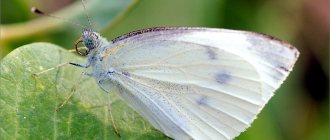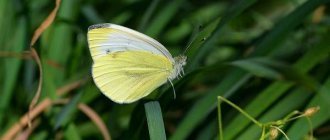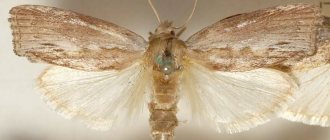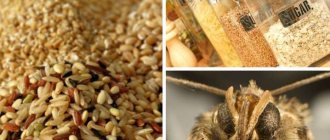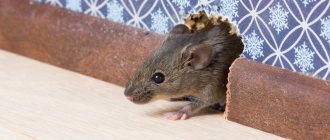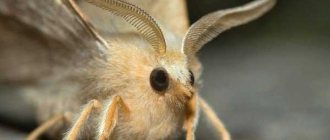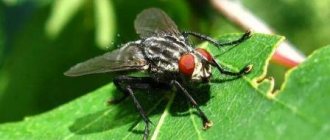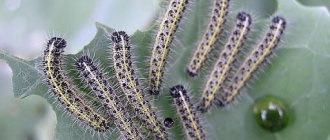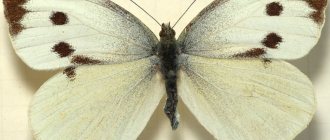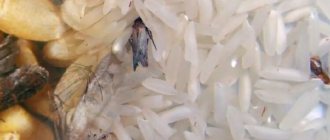Cabbage moth
Cabbage moth is one of the main pests of cruciferous crops . Its danger is confirmed by the fact that in some years in fields and private plots the insect is able to squeeze out its competitors in the fight for food - cruciferous flea beetle, rapeseed leaf beetle, cabbage aphid.
Description of the pest
An adult insect is a small butterfly with narrow wings of various colors. Shades vary from brown-gray to dark brown.
On the front wings, a light yellow or white wavy stripe runs along the rear edge, forming a diamond-shaped pattern when the wings are folded. The hind wings are gray-silver with long fringes along the edges.
The pest lays small, slightly flattened eggs . After laying, they are colored white-yellow with dark dots, and over time they become lemon-yellow.
The body of the larvae (caterpillars) is 7–12 mm long, has a spindle-shaped shape - it is narrowed in front and behind. Young larvae are white with a brown head. As they develop, after 3–4 molts, their body turns light green or dark brown, sparse dark bristles appear, and dark spots appear on the head. The caterpillars are mobile and move on 16 legs.
Caterpillars complete their development by turning into pupae. This process occurs on plants; yellow or green pupae are protected by an elongated gray-white cocoon.
Why is it dangerous?
An adult butterfly does not harm vegetable crops. Only moth caterpillars gnaw through the leaves. Damaged leaves become stained, gradually wither and fall off. Plant growth and fruit set slows down. If the damage is extensive, the plant begins to rot and die. The caterpillars move to a neighboring crop.
If measures are not taken to destroy the parasite, moth larvae can destroy an adult plant in just two days. It happened that the pest’s attacks destroyed entire rapeseed fields in a week.
Life cycle
In the central zone, the appearance of the pest occurs at the end of April, in the south - at the beginning of April, and in the northwestern and eastern regions, insects begin to fly in May-early June.
They are active in the late evening or at night, and during the mating period they are visible during the day. Insects do not rise into the air higher than 2 m and do not fly long distances on their own. The wind carries them for many kilometers.
Female cabbage moths lay an average of 80–170 eggs. They attach them along the veins on the bottom of the leaf or at the base of the petioles. After 3–6 days, voracious caterpillars emerge from the eggs.
They live for 10–15 days, feeding inside the leaves for the first 2–3 days, and then emerging to the surface. During this period, the first molt occurs. In total, the caterpillar molts 3–4 times every 2–3 days. Before each time, the larva weaves a protective cover, which is attached to the underside of the leaf, then climbs under the canopy and only then moults.
Caterpillars have a good reaction; at the slightest danger, they begin to wriggle, curl into an arc and descend from the leaf to the ground on a web. A white cocoon is constructed from the same silk threads, in which pupation takes place. This stage lasts 7–15 days. The pupae can withstand low temperatures and remain over the winter, turning into butterflies in the spring of the following year .
Depending on temperature conditions, the development of one population takes 35–40 days . Females live 1 month, males live 20 days. In just one season, 3–4 generations of the pest may appear.
Chemicals
The chemicals contain toxins that cause paralysis of the nervous system of insects. After 2-3 days the pest dies. But it should be remembered that toxic substances are also dangerous for humans. Therefore, vegetable crops must be processed a month before harvest.
Before use, you must carefully read the instructions: you must strictly observe the proportions of concentrate and water, the consumption of the finished chemical per 1 sq.m. Do not forget about precautions: carry out processing with safety glasses and rubber gloves. An important condition for obtaining a positive result is weather conditions (do not use drugs before it rains).
"Fury"
The drug “Fury” belongs to the group of synthetic insecticides. Ingestion of toxins through food leads to paralysis of the caterpillar. The pest loses the ability to move and feed. The chemical is also used for preventive purposes. The protective effect lasts about half a month. “Fury” is not recommended for use during the head setting period.
The advantages of the chemical include: high efficiency, lack of resistance, long shelf life. Disadvantages: dangerous for bees. It belongs to the 3rd category of danger, so you cannot spray plants located near natural bodies of water.
Chemicals should be used to treat cabbage with caution.
“Sumi-Alpha”
“Sumi-Alpha” has a contact-intestinal effect. It is characterized by high lethal activity. Insects die within 2 hours. Does not accumulate in the fruits of processed crops. Economical: low application rates allow you to process large areas of vegetable crops. Does not harm the health of humans and pets. Resistant even to prolonged exposure to sunlight.
“Inta-Vir”
“Inta-Vir” is a synthetic analogue of natural insecticides. The sprayed drug does not penetrate into the pulp of the leaves, but remains on the surface in the form of a thin film. The active substance, entering the pest’s body, blocks the functioning of the nervous system. After 2-3 days the insect dies. If after this time no positive effect is observed, other methods of control should be used. This is due to the high resistance of pests to the chemical.
Before use, it is necessary to familiarize yourself with the weather forecast for the next day, since high humidity reduces the effect of the product.
What does the affected plant look like?
The eggs of the pest attach to the underside of the leaf, and the hatched larvae immediately penetrate the leaves and eat away the internal tissues . They make short moves (mines), but do not damage the skin.
After 2–3 days, the caterpillars switch to open feeding and eat holes in the leaves . As the larvae develop, these holes increase in size. During mass infection, plants lose all leaf tissue, leaving only veins .
Often the pest completely eats up the stems and seeds. In cabbage heads, caterpillars climb into the center and destroy the apical bud along with the leaves . As a result, plants lag behind in development, become deformed and the yield decreases.
Pheromone traps
Pheromones are external secretion products that insects secrete to communicate with each other. With the help of capsules with these volatile substances, you can attract the attention of pests and lure them into a trap. A structure is made from cardboard, inside which a dispenser containing pheromones is placed. The bottom of the trap is generously lubricated with glue containing toxins. Attracted by pheromones, butterflies fly inside the structure, stick to the liner and die.
Pheromone traps are used only to capture adult individuals. The devices do not harm the environment or human health.
Causes of the pest
The appearance of cabbage moths is cyclical and depends on climatic conditions (temperature and humidity). It has been established that the massive spread of the pest is observed in years when winters were warm and humid . This promotes the early development of cruciferous weeds, which become a food source for the first generation of caterpillars. Further accumulation of positive temperatures contributes to the successful development of the first generation and the appearance of the second population of the pest at the end of June.
In hot and dry summers, the cabbage moth in some regions becomes the main pest of cruciferous crops.
It was also noted that a sharp increase in the number of the pest occurs after 6–8 years of continuous cultivation of plants in one place.
How to detect on cabbage
If there are moths on the site, all cruciferous vegetables must be treated, otherwise the reproduction process cannot be stopped. At risk:
- turnip;
- mustard;
- rape;
- arugula;
- radish.
Butterflies begin to fly over plants after sunset, so it is difficult to notice them. Caterpillars can be identified by damaged leaves. You need to examine the inside, there should be larvae there.
The affected plant becomes weak and yellow spots appear on the leaves. In advanced cases, yellowing spreads to the head of cabbage. Growth stops, rotting is possible.
Having made sure that there are caterpillars, it is urgent to select suitable control measures. Further reproduction of butterflies will lead to the appearance of next generations and abundant seeding of cruciferous crops on the site.
What crops are affected by the pest?
The cabbage moth damages all cruciferous crops . In nature, it attacks wild radish, shepherd's purse, rapeseed, wild rapeseed, field reddish, and wildflower .
The pest has special preferences among cultivated plants. Larvae and butterflies feed on all types of cabbage. They love rapeseed, mustard, radishes, turnips, rutabaga, horseradish, turnips .
The pest is especially dangerous for young plantings. Due to damage to the central sockets, they may completely die.
Features of cabbage moth
This pest belongs to the species of butterflies of the sicklewing family. The cabbage moth lives mainly in the steppes and forest-steppes of our region. Damages cabbage and other cruciferous crops: rapeseed, mustard, turnips.
People involved in gardening know what the cabbage moth looks like: the body is elongated, thin, discreet green or brown in color. The wingspan length is from 1 to 1.5 cm.
Located on the leaves of plants with unstretched wings, the pest resembles a straw.
In the caterpillar stage, it eats only plant leaves, but adults prefer flower nectar. However, far from the place where it emerged from the pupa, the cabbage moth is not able to fly away.
Means of struggle
Chemical and biological agents
Inta-vir
Effectively destroys the pest during mass infestation. Use in a concentration of 1 tablet per 10 liters of water. Plants are treated no more than 2 times.
Sumi alpha
Pyrethroid drug, toxic to pests of cruciferous crops. Plants are treated 1–2 times before heads and root crops begin to set. The dosage of the drug is 5 g per 10 liters of water.
Fury
Broad-spectrum insecticide. To destroy cabbage moths, the consumption rate of the drug is 1 ml per 10 liters of water.
To avoid addiction, it is recommended to alternate chemical insecticides. At the initial stage of infection, biological drugs are effective. They act on the intestinal system of pests, destroying them in 1–3 days. All biological agents are used in the morning or evening in dry, windless weather at an air temperature of 18–30°C.
Bitoxibacillin
Biological product in the form of a light brown powder. To treat plants, 40–50 g of the product are dissolved in 10 liters of water. Spraying is carried out 1-2 times with a break of 7-8 days.
Lepidocide
The working solution is prepared at the rate of 20–30 g per 10 liters of water. The maximum number of treatments on cruciferous crops is 5 times with an interval of 7 days.
Traditional methods
- 1 kg of fresh tansy is poured into 10 liters of water, put on fire and brought to a boil. After cooling, the solution is filtered and used for spraying.
- Take 200 g of tobacco and onion peel , pour the mixture with 10 liters of water. The solution is boiled for 2 hours. At the end, add 200 g of chopped garlic cloves to the broth. The cooled solution is filtered and water is added instead of boiled water to bring the volume of liquid to 10 liters.
- 100 g of mustard powder is poured into 10 liters of boiling water and left for 2 days. The solution is filtered and diluted with water in a 1:1 ratio before use.
- 1 kg of dry or 0.5 kg of crushed fresh dandelion is poured into 10 liters of hot water. The solution is infused for 12 hours and then filtered. For spraying, the concentrate is diluted with water in a ratio of 1:3 and 1 tbsp is added. l. liquid soap.
Herbal decoctions and infusions are used to destroy young caterpillars of the pest . The liquid should get on all above-ground parts: on the upper and lower sides of the leaves, petioles and stems.
Pest butterflies are eliminated using traps . Pieces of cardboard are painted with yellow paint or covered with yellow paper. The surface of the cardboard is lubricated with a sticky agent: Vaseline, grease, thick glue. These traps are hung around garden beds.
Prevention rules
Preventing an insect attack is easier than destroying it without loss of yield. When fighting cabbage moths, follow these recommendations:
- follow the rules of crop rotation, annually changing the location of the cabbage bed;
- place areas with different cruciferous crops farther from each other;
- In the fall, dig the soil deeply and add nutrients;
- Regularly remove weeds and destroy plant debris.
To prevent the spread of moths, insecticide treatments are done as planned, and not when a pest is detected. It is permissible to use folk remedies for this purpose, but it must be taken into account that their effectiveness is lower than that of industrial preparations.
Harm
By damaging the leaves of cabbage and other crops, moth caterpillars doom the plants to lack of nutrition, which leads to general oppression of the plant and a lag in its development. Moreover, cabbage moth larvae feed on almost all cruciferous vegetables, including:
- white and red cabbage;
- savoy cabbage;
- broccoli;
- cauliflower;
- kohlrabi;
- turnip;
- radishes;
- radish;
- daikon;
- mustard;
- rapeseed;
- Brussels sprouts;
- and maybe I missed something else.
Farmers and agricultural enterprises suffer from cabbage moths on rapeseed and mustard crops; pests that appear on the outskirts of fields quickly move to their center, damaging large areas of crops.
Preventive actions
To prevent pests from appearing on garden plants, it is necessary to carry out agrotechnical measures:
- Timely removal of weeds from the beds (especially in spring), since the first egg laying occurs on them.
- Regular collection of dead leaves.
- Deep plowing of the soil in autumn. Moth pupae often overwinter in the soil, so it is recommended to turn out clods of soil before the onset of frost.
- Mandatory autumn collection of organic waste remaining after harvesting. Plant residues (stems, leaves, stems) should not be stored in a compost bin; it is better to completely destroy them (burn them).
- Covering the beds with protective materials: spunbond, agrofibre or mesh with small cells.
- Planting in neighboring areas plants that repel pests: coriander, parsley, celery, lemon balm, tobacco, garlic, etc.
- Mandatory feeding of seedlings to increase resistance to pests. It is recommended to use a mixture of potassium and superphosphate.
- Maintaining crop rotation.
- Regular inspection of the leaves and stems of the plant.
It must be remembered that the destruction of mass accumulations of pests is a labor-intensive process. A large number of caterpillars have to be controlled only with the help of chemicals, which can affect the quality of the fruit. Therefore, experienced agronomists advise not to neglect preventive measures.
